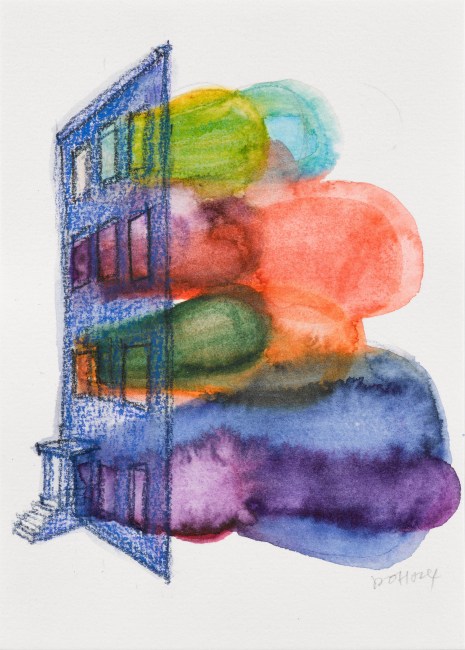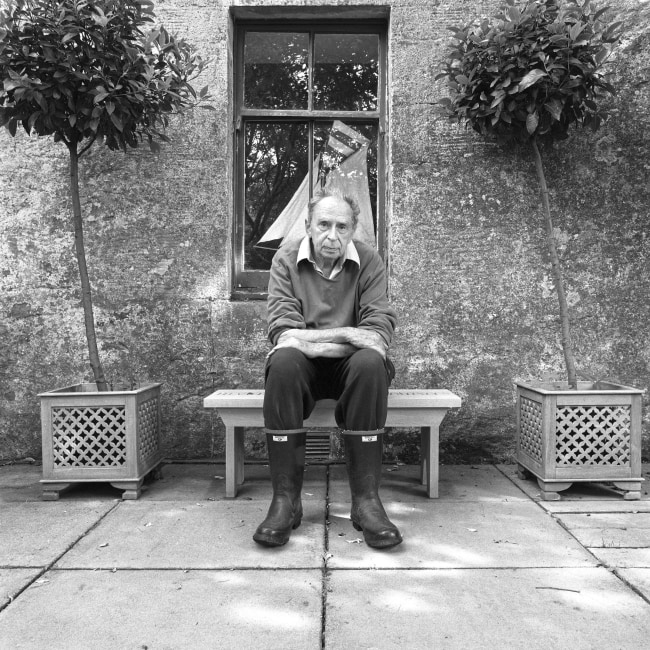An exhibition comprising paintings and an installation of lamps by the Mexico-based Cuban-American artist.
Celebrated for his use of vibrant colours, eclectic patterns and natural and industrial materials, Pardo, a MacArthur Fellow, has since the 1990s drawn on the historical intersections of fine art, architecture and design to create a highly individual body of work. Characterised by its fluidity between genres, his diverse output ranges from paintings, sculptures and murals to furniture and even entire buildings. Pardo’s focus on multiple meanings, purposes and contexts invites constant re-evaluation of objects, images and architectural space.
The exhibition features suspended and freestanding lamps, ranging in scale from one to 1.7 metres tall, distributed at varying distances from one another throughout the first-floor gallery. Distinguishable by a number of components and forms – including sinuous lines of laser-cut PETG plastic resin that surround a central light fitting, and lengths of the same material, sometimes perforated with rectangular or triangular motifs, that hang in fringed formations – Pardo’s lamps offer an extended consideration of physicality and immateriality, the visible and invisible. While the lamps themselves possess sculptural form as objects, sometimes recalling natural phenomena such as animal and plant life, the light they emit, variously controlled and directed, is less tangible. This is experienced in the spaces between each work and the surrounding architecture – an irregular play of light and shadow which itself might be altered by viewer’s movements through the space.
In addition, new paintings, ranging from two metres to almost five metres in height, are installed in the ground floor gallery and in the atrium space that connects the gallery floors. While they are called paintings, these wall-mounted works are composed of layers of laser-cut birch wood ply and MDF, milled, perforated and painted so that evocations – of colour, form and image – seem to shift and dissolve as the viewer moves in front of them. Ostensibly completed in single colours – red, orange, yellow and blue – up close the works reveal tesserae-like surfaces of complementary and tertiary hues. These interact with the routed circular and linear motifs, topographical in appearance, of the layers underneath to create moiré-like patterns of interference, through which suggestions of landscape and weather are revealed. The forms of the paintings themselves recall folding screens installed on their sides and bolted to the wall (and thus robbed of their function), though the impression of the hinged panels projecting into space is another illusion. Rather than concertina into space, the works are resolutely flat.
Poised between the organic and the manmade, the practical and the poetic, Pardo’s art playfully insists that form needn’t necessarily follow function (or vice versa) instead suggesting multiple and mutating definitions and applications that toy with our expectations. Together, the works in the exhibition expand upon the artist’s ongoing exploration into questions of composition, classification of genres and categories of production and display.
About the artist
Born in Havana, Cuba, in 1963, Jorge Pardo relocated to Chicago, USA, with his family as a child. He studied at the University of Illinois, Chicago and received his BFA from Art Center College of Design in Pasadena, California. Pardo’s work has been the subject of numerous solo exhibitions at international institutional venues including Irish Museum of Modern Art, Dublin (2010); K21 Kunstsammlung Nordrhein-Westfalen, Düsseldorf (2009); Los Angeles County Museum of Art (2008); and Museum of Contemporary Art, North Miami (2007). He has been included in numerous significant group exhibitions including Display – between art and arts & crafts, Applied Arts Pavilion, the 57th Biennale di Venezia (2017); Okoyama Art Summit (2016), Viehof Collection: International Contemporary Art, Deichtorhallen, Hamburg (2016); You’ve Got to Know the Rules … to Break Them, de la Cruz Collection, Miami (2015); Beyond the Supersquare, The Bronx Museum of Arts, New York, US (2014); KölnSkulptur #7, Skulpturenpark Köln, Cologne (2013); Print/Out, MoMA Museum of Modern Art, New York (2012); Art of Communication: Anri Sala, Yang Ah Ham, Philippe Parreno, Jorge Pardo, National Museum of Art, Deoksugung (2011); The Jewel Thief, The Frances Young Tang Teaching Museum and Art Gallery, Skidmore College, Saratoga Springs, (2010); theanyspacewhatever, Solomon R. Guggenheim Museum, New York (2008); Index. Conceptualism in California from the Permanent Collection, The Geffen Contemporary, Museum of Contemporary Art, Los Angeles (2008); Birth of the Cool. California Art, Design, and Culture at Midcentury, Orange County Museum of Art, Newport Beach, US and tour (2007); Works from the Tate Collection, Tate Modern, London (2006). In 1996, along with artists including Carsten Höller, Pierre Huyghe and Rirkrit Tiravanija, Pardo was featured in Nicolas Bourriaud’s exhibition Traffic at CAPC Musée d’Art Contemporain de Bordeaux, in the catalogue for which Bourriaud coined the term ‘Relational Aesthetics’.
Permanent works and public projects include Streetcar Stop for Portland, Regional Arts and Culture Council, Portland (2014); Plat 99, Bar and Lounge designed for The Alexander Hotel, Indianapolis, (2013); Tecoh, private residence, Yucatán (2012); Untitled (reinstallation of the Latin American Galleries), LACMA Los Angeles County Museum of Art, Los Angeles, US (2008); Untitled (Guadalajara Light Piece), Solares Foundation, Guadalajara (2005); House for Cesar and Mimi Reyes, Old San Juan (2004); Project, a reimagining of the lobby and new bookshop for Dia Art Foundation Chelsea, New York, US (2000); 4166 Sea View Lane, a proposal as part of an exhibition for LA MoCA to build an artist’s house on a hillside in Mount Washington, Los Angeles, for which Pardo designed every element of the building (completed 1998).
Pardo’s work is part of numerous public collections including the Museum of Contemporary Art, Los Angeles; Museum of Modern Art, New York; and Tate, UK. He has been the recipient of many awards including the MacArthur Fellowship Award (2010); the Smithsonian American Art Museum Lucelia Artist Award (2001); the Louis Comfort Tiffany Foundation Award (1995).
Jorge Pardo lives and works in Mérida, Mexico.



















